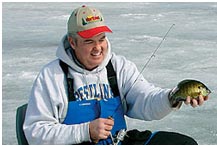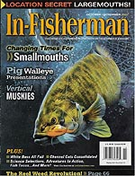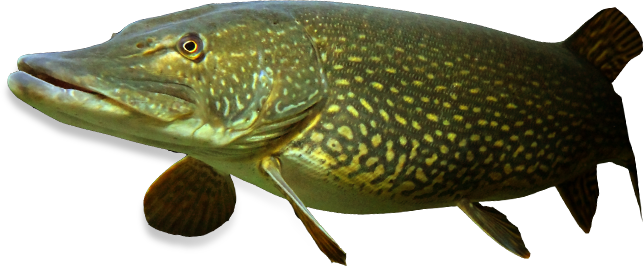"Faking It"
by RON ANLAUF
Build your own hotspot with artificial weeds
If you found a small bed of green weeds sprouting in an area otherwise devoid of vegetation, would you fish it?
How about a patch of greens tucked in the corner of a rock pile, where weeds are normally unable to take root? ![]() Would you fish that? You bet you would.
Would you fish that? You bet you would.
Weeds attract and hold baitfish, panfish and larger predators. Crappies, 'gills, bass, pike, muskies and walleyes all frequent vegetation during winter. Still, veteran weed warriors know that day in and day out, specific spots are better than others. One of the hottest is a patch of weeds growing just a little deeper  than the rest. Finding an area like that takes time and effort, though, and isn't always practical, especially if you're on an unfamiliar body of water and time is limited.
than the rest. Finding an area like that takes time and effort, though, and isn't always practical, especially if you're on an unfamiliar body of water and time is limited.
Finding weeds where they don't normally grow, such as on a rock bottom, is an even taller task, and sometimes requires a small miracle. Fortunately, you don't need a lot of time or divine intervention to get the job done. You just need a few extra holes and a bucketful of weeds.
Not the real thing. That wouldn't be ethical or, in some cases, even legal. Rather, deploy lifelike fake weeds. You can find them at pet stores, where they are sold for use in aquariums. Or, try new Structure On A String from LaDredge Outdoors. It's a natural-looking plastic that can be dropped anywhere, letting you create your own hotspot.
Each weed string resembles a strand of milfoil and is attached to a cord with a weight at the bottom, a float at the top, and is wound on a handy spool. The float is adjustable and designed to keep the strand hanging straight up and down.
SOUND GARDEN
A single strand can attract fish, but more elaborate sets comprised of multiple strands are better. The idea is to create a configuration that will draw and hold fish, then funnel them to your line. The exact shape and size can vary according to where you're fishing.
If you're on the bottom of a break, perhaps on an inside turn or the tip of a point, a V-shape that conforms to the structure can funnel fish to centrally located baits. On top of a weedless hump or other relatively flat structure, a circular pattern with lures or baits set in the center can be better. An hourglass pattern is another option, with lines set in the narrows.
Deployment is easy. To make the breakline set, for example, drill six or seven holes in a V, then punch a hole or two in the center to fish out of. Drop the weeds into place, making sure the cords are tight so the strands stand straight.
Next, drop your lures and start fishing. It may take 15 minutes to an hour for fish to really start funneling in, but the difference compared to fishing weedless water is noticeable.
Fake weeds work wonders with tip-ups, too. Even a single strand a few feet from the flag will draw more visits from fish cruising nearby.
One word of caution, though. If you're pike fishing, unwrap all the cord from the holder, just in case a pike tangles with it during the fight; you don't want to lose the entire rig to an angry 'gator. You can also reduce your chances of tangles by pulling in the nearest weeds before setting the hook.
NOT EVERYWHERE
Fake weeds can be set up and retrieved in relatively short order, but they really aren't practical when you're in search mode looking for fish.
A better time to build a false garden is after you've found a fishy-looking area and decide to dig in and see what you can put on the ice.
Likely areas to attack include those void of any other structure, spots where fish are more apt to be on the move, and areas that loosely funnel fish, but could use a little tightening.
An underwater camera can help you see how fish relate to your set, as well as boost your confidence in the whole fake weed concept. When the first wave of crappies settles in, you'll start to believe. The downside of dropping an underwater camera is it can spook fish, especially walleyes and crappies.
LaDredge addressed the spooking problem by designing Camera Cable Structure-a strand of weeds that attaches to the cable-which helps camouflage your underwater eye.
The key is keeping the whole affair perfectly steady when fish are present because even slight movements can cause immediate evacuation.
Besides running and gunning, fake weedbeds can be impractical during extreme cold or other challenging weather conditions, such as blowing snow. Note: If the float freezes in, a quick squeeze may free it from the ice.
While the use of permanent artificial fish attractors isn't new, portable cover certainly is. Weeds that can be placed where you want them, when you want 'em, then removed when you're done provide a host of options, and will give you plenty to think about, too.

I began using Reel Weeds last year with excellent results. A very well constructed product that will last you for many seasons.
Scenic TackleSPOTLIGHT: In-Fisherman
Reel Weeds--Real Deal
Reel Weeds are mobile artificial fish attractors closely resembling freshwater weeds, and while the use of artificial fish attractors isn't new, incorporating the idea into a portable system is. The concept is designed to mask the otherwise unnatural profile of underwater camera cables and camera head... View Article





